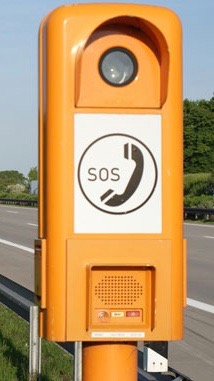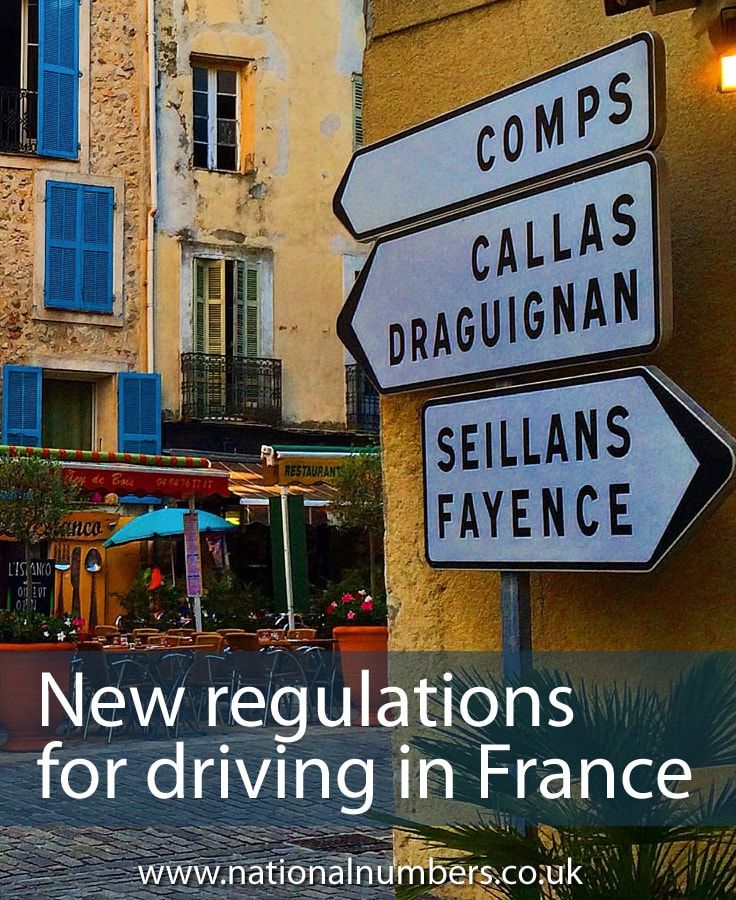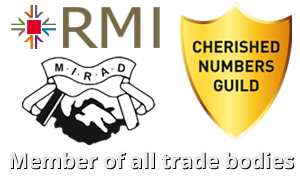This month the UK joins the EU system to share driver details across borders for some safety-related driving offences committed after 6 May 2017.
It applies:
- where the offender isn't penalised while still in the country
- to specific, road safety-related offences:
- Speeding
- Drink/drug driving
- Seatbelt/crash helmet
- Red light/forbidden lane
- Mobile phone offences
What does this mean?
If you commit one of the listed offences after 6 May 2017 and the authorities in another country request your details, then DVLA will now have to provide them with details of the registered keeper/owner at the time of the alleged traffic offence. If the authorities in another EU country contact DVLA within 12 months of the date of the alleged offence with:
- Details of the alleged offence (date, time, location).
- Vehicle registration number.
- Vehicle category and, if known, its make and model.
Driving in France this summer?
Apart from driving on the right and overtaking on the left, what else do you need to know about driving in France?
How old do I need to be?
- The minimum age to drive a car or motorcycle (over 80cc) bought into the country is 18 years old.
- For a motorcycle, up to 80cc, the minimum age is 16.
- To drive a French hire car the minimum age is generally 21 years old but car hire companies have differing rules around minimum and maximum age limits.
What insurance do I need?
The minimum required is third-party cover. It is important to check that any fully comprehensive cover is also applicable abroad and it is also prudent to have some European breakdown cover.
What must I carry in the vehicle by law?
Drivers can be fined on the spot for not carrying certain items in France:
- Headlamp converters
- Hi Viz Vests (for all those in the vehicle)
- GB sticker (also for any towed vehicles)
- Warning triangle
- Spare bulbs
- Breathalysers which must be unused and certified (showing an 'NF' number) (currently no fine)
- Spare glasses (if glasses are worn for driving)
- Snow chains - snow chains must be fitted when driving on snow-covered roads in accordance with local road signs. A maximum speed limit of 50km/h (31 mph) applies
- Pollution sticker when driving in an environmental zone
- Passport
- Driving licence
- V5 (log book)
- Insurance documents
- MOT certificate if appropriate
What do I need to know about buying petrol?
- Unleaded petrol (sans plomb - 95 and 98 octane), diesel (Gazole) and LPG are all sold at petrol stations.
- SP95-E10 (with 10% Ethanol) and B8 (with 8% biodiesel) biodiesel are available but are not suitable for all cars.
- Generally French petrol stations accept mainstream British credit cards for payment but some drivers have experienced problems at unmanned pumps. Motorway service stations tend to be manned 24 hours.
- For electric cars, there are web directories available showing charging points.
What are the speed limits?
Speed limits are in kilometers per hour.
- Highway(Autoroute/Motorways): 130 km/h (80mph)
When- it is raining
- driver's license is less than 3 years old
- a trailer with a combination gross weight over 3.5 tons: 110 km/h (70 mph)
- Dual carriageway/ urban motorways: 110 km/h (70 mph)
When- it is raining
- driver's license is less than 3 years old
- a trailer with a combination gross weight over 3.5 tons: 100 km/h (60 mph)
- Open road outside built up areas: 90 km/h (55 mph)
When- it is raining
- driver's license is less than 3 years old
- a trailer with a combination gross weight over 3.5 tons: 80 km/h (50 mph)
- Towns/built up areas: 50 km/h (30 mph)
What road signs do I need to be aware of?
A comprehensive list is available at http://www.drivingtesttips.biz/french-road-signs.html
The following are useful to understand:
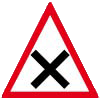 | This means that there is a junction ahead and you must give way to traffic from the right. |
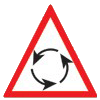 | Roundabout, give way to the left when entering the roundabout. Note: Where you see "Vous n'avez pas la priorité" or "Cédez le passage" at a roundabout - traffic on the roundabout has priority; where no such sign exists, traffic entering the roundabout has priority. |
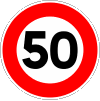 | Typical speed limit road sign (Km per hour). |
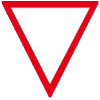 | Give way to traffic from the left or right. |
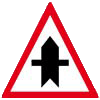 | There is a junction ahead, and you have the priority. |
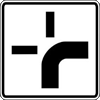 | Priority sign – in this example the road turning right that has priority. |
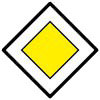 | Priority. |
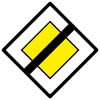 | End of priority on this road- must now give way to traffic from the right. |
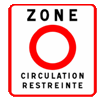 | Entering an environmental zone and must display a sticker showing the vehicles carbon emissions. |
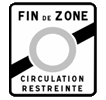 | Leaving an environmental zone. |
What do I need to know about French Motorways (Highways)?
These are usually toll roads and will have a toll booth (péage). Payment can be by cash or credit card and are payable for each section. There are rest areas (Aires d'autoroute) every 10 to 15 kilometres.
What happens if I breakdown?
- French motorways are privately managed so drivers cannot use their own breakdown service. They must use the orange telephones boxes which should be every 2km along the road. If an orange phone cannot be accessed, the emergency services can be phoned: 112.
- The assistance service provided may deal with minor problems where the breakdown happened are or will take the vehicle and occupants to a safe area where the drivers can use their chosen breakdown service. Charges for these services are set by the government and depend whether the service is provided between 8am and 6pm Monday to Friday or at the weekend or public holiday.
- If the vehicle breaks down on the motorway the driver should pull into the roadside or had shoulder. A red triangle must be placed at 100m (109 yards) from the car on motorways and 30m (32 yards) on other roads. If not possible (towns for instance), the distance can be reduced.
- The occupants must
- Put on the hazard lights.
- Get out of the vehicle and stand at the roadside or hard-shoulder. Everyone must wear hi visibility clothing as soon as they are outside the vehicle.
What are the drink/driving laws in France?
The limit is 0.50g per liter of blood (it is 0.80g/l in the UK). For new drivers (license held for less than 3 years) and bus/coach drivers the limit is 0.2g per litre of blood. The same penalties apply for drugs as those for driving under the influence of alcohol. The French police can carry out random breath tests.
What else do I need to know?
- It is illegal to park within 5 meters of a pedestrian crossing.
- It is illegal to use a mobile phone whilst driving including using a headset or headphones. The only type of mobile phone now legal to use in France while driving is one that is entirely hands-free and headphone free. It is also illegal to listen to music or radio through headphones.
- Front and rear seat occupants must wear seat belts (if they are fitted).
- Children up to the age of 10
- must travel in an approved child seat or restraint suitable for their age and size.
- aren't allowed to travel in the front seat unless there's no rear seat, or the rear seat is already occupied by children under 10, or there are no seat belts in the rear.
- It is the driver's responsibility to ensure that all passengers under 18 are appropriately restrained in the vehicle.
- Dipped headlights must be used in poor daytime visibility and is recommended for all daytime driving.
- A crash helmet must be worn by riders on any two-wheeled vehicle.
- All helmets must display legally recognized reflective stickers on the front, rear and sides.
- The driver and passengers of mopeds, motorcycles, motor tricycles and motor quadricycles must wear a pair of CE-certified gloves whenever they are riding the vehicle.
- When passengers are boarding or getting off a stationary tram, you must not overtake.
- When overtaking a bicycle a distance must be left between your vehicle and the bicycle of at least:
- 1m in built-up areas.
- 1.5m outside built-up areas.
- The horn must not be used in built up areas except in cases of immediate danger.
- A device with a screen which can distract a driver must be positioned so that the driver is unable to see them.
- Devices must not be touched or programmed unless parked in a safe place.
- It is illegal to carry, transport or use radar detectors.
- All GPS-based navigation systems with maps that can show the location of fixed speed cameras must have that function deactivated and ideally removed.
- If a trailer is being towed, it must have two red lights, two triangular reflectors and a light illuminating the registration plate at the rear and orange reflectors on each side. If the trailer is more than 1.6m wide or is wider than the vehicle by more than 20cm there must be two white reflectors and two white side lights at the front of the trailer.
- "Priorité à droite" is an old unrepealed French rule which means that when driving along a road, anyone joining from the right-hand side has priority over the main carriageway on which you are driving. They do not have to stop, instead you must slow and give way to them, regardless of the size of the adjoining road. It is highly unlikely to apply on any main roads but could apply in rural areas.
This information is given just as a guide and should not be taken as the law. Whilst we have taken every possible care to ensure the information is correct we cannot be held responsible for any errors.

